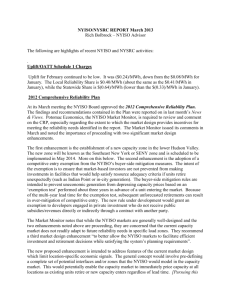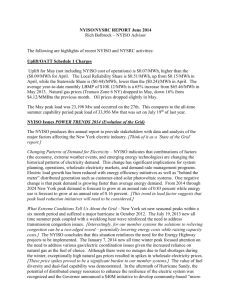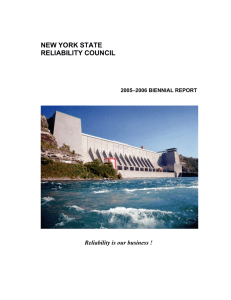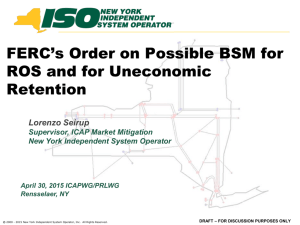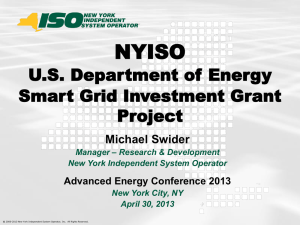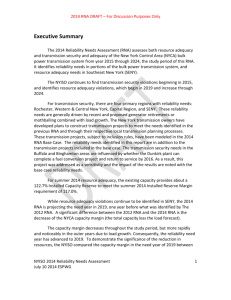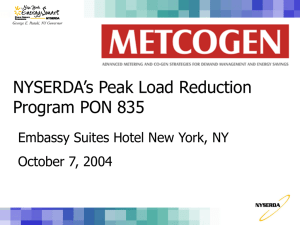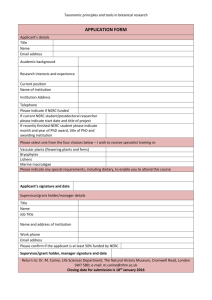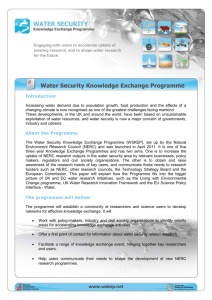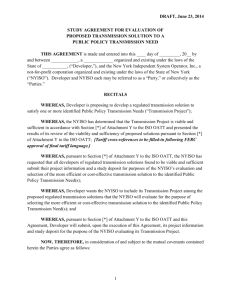National Grid - Redline Initial Planning Process
advertisement
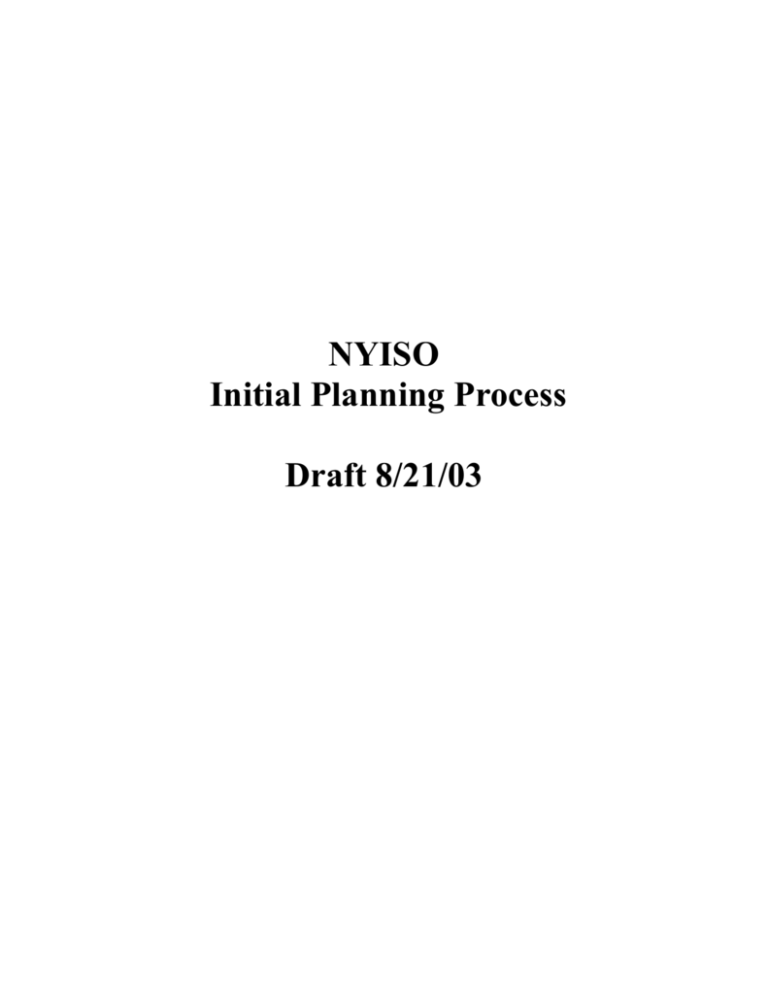
NYISO Initial Planning Process Draft 8/21/03 NYISO Initial Planning Process Table of Contents 1. Introduction ............................................................................................ 2. Stakeholder Process ............................................................................... 3. Planning Criteria and Objectives ......................................................... 3.1. Reliability Criteria ........................................................................... 3.1.1. NERC ....................................................................................... 3.1.2. NPCC ....................................................................................... 3.1.3. NYSRC..................................................................................... 3.2. Objectives ........................................................................................ 3.2.1. Reliability Needs Assessment ................................................. 3.2.2. Historic Congestion ................................................................. 4. Process ..................................................................................................... 4.1. Overview ......................................................................................... 4.2. Input Stage ....................................................................................... 4.2.1. Input Requirements .................................................................. 4.2.1.1.Load and Capacity Data Report ............................................ 4.2.1.2.Existing Reliability Assessments .......................................... 4.2.1.3.Short Circuit Data ................................................................. 4.2.2. Input from Neighboring Areas ................................................. 4.2.2.1.Forecasted Load, Facilities and System Conditions ............. 4.2.3. Input from Stakeholders ........................................................... 4.2.4. Baseline .................................................................................... 4.2.5. Scenario Development ............................................................. 4.3. Analysis Stage .................................................................................... 4.3.1. Historic Congestion .................................................................. 4.3.1.1.Summary Reports ................................................................. 4.3.1.2.Selective Cause Analysis ...................................................... 4.3.2. Baseline Reliability Needs Assessment ................................... 4.3.3. Evaluation of Alternate Scenarios ............................................ 4.3.4. Report Preparation.................................................................... 4.4. Review Process .................................................................................. 4.4.1. Stakeholder Review.................................................................. 4.4.2. Board Action ............................................................................ 5. Issuance of Final Report ........................................................................ 5.1. Follow Up Discussions ...................................................................... 6. References ............................................................................................... 7. Figures ..................................................................................................... Attachment A – Process Flow Chart Attachment B – Stakeholder Participation Attachment C - Timeline Draft for Discussion Purposes Only 1. Introduction The NYISO Initial Planning Process is the first phase in the development of a comprehensive planning process for the NYISO. This process is being developed by NYISO Staff with assistance of the Electric System Planning Working Group (“ESPWG”), an ad- hoc committee comprised of BIC and MC representatives. The Initial Planning Process will focus on the consolidation of the existing NYISO reliability-based analyses, an extension of those reliability analyses from 5 to 10 years, and the addition of scenario analyses to the base case conditions. In addition, the Initial Planning Process will include the reporting of historical congestion costs and selective analysis of the causes of historic congestion in order to provide information to the marketplace to assist in future decision making. (See Attachment A for the Process Flow Diagram depicting the major elements of this Initial Planning Process.) It is anticipated that development efforts on the Comprehensive Planning Process (Phase II) will begin immediately upon the establishment of the Phase I process. The Phase II discussions will address the various FERC planning requirements of Order 2000 and the SMD NOPR, including both reliability and economic issues. It is anticipated that a FERC filing will be required for the Comprehensive Planning Process. 2. Stakeholder Process In light of the fact that the Initial Planning Process contains both reliability and economic features, it has been agreed that both the Transmission Planning Advisory Subcommittee (“TPAS”) and the ESPWG will participate in the implementation process. This participation will consist of parallel input and review stages as shown in Attachment B. TPAS will have primary responsibility for the reliability-based analyses, while the ESPWG will have primary responsibility for providing commercial input and assumptions utilized in the development of future scenarios as well as provide input into the reporting and analysis of historic congestion costs. Coordination will be established between these two groups and with NYISO Staff during each stage of the planning process. The intention is to achieve consensus at both TPAS and the ESPWG. While no formal voting process has been established at this level, an opportunity for reporting majority and minority views will be provided in the absence of a consensus. Following TPAS and ESPWG final review, the NYISO Staff’s Final Draft Report will be forwarded to the Operating Committee (“OC”). See Section 4.4.1 for a further description of the Stakeholder Review Process. 1 Draft for Discussion Purposes Only 3. Planning Criteria and Objectives The New York Control Area (“NYCA”) power system is planned and operated to the planning and operating policies, standards, criteria, guidelines, procedures and rules promulgated by the North American Electric Reliability Council (“NERC”), Northeast Power Coordinating Council (“NPCC”), and the New York State Reliability Council (“NYSRC”). NERC establishes operating policies and planning standards for North America which includes the United States of America and the Provinces of Canada. NPCC criteria, guideline and procedures which apply to the five areas comprising NPCC (New York State, the New England States, and the Canadian Provinces of Quebec, Ontario and the Maritimes) may be more specific or more stringent than NERC standards and policies by recognizing regional characteristics or reliability needs – e.g., “the one day in ten years” loss of load expectation criteria. The NYSRC rules that apply to NYCA may be more specific or stringent than NERC and NPCC by recognizing NYCA characteristics and reliability needs – e.g., locational capacity requirements. The NYISO is the primary interface between market participants and the reliability councils. The chart below presents an overview of those interfaces. Overview of the NYISO Reliability Interfaces NERC NERC Standards NPCC Standards NPCC ISO COMPLIANCE ASSESSMENTS [NYSRC(N) Rules] NYSRC NYSRC(N+S) Rules NYISO Process for Compliance Monitoring ISO COMPLIANCE ASSESSMENTS [NYSRC(S) Rules] DISPUTE RESOLUTION MP COMPLIANCE ASSESSMENTS [NYSRC(N+S) Rules] NYSRC(N+S) Rules Process for Rules Notification NYSRC(S) Rules* Market Participants * 2 NYSRC Rules include criteria established by NERC, NPCC, FERC, PSC, and NRC. N – Rules are NPCC rules S – Rules are State specific rules. Draft for Discussion Purposes Only The objective of the initial planning process is to perform a regional analysis of the NYCA electric system that results in identified system needs and will strive, at a minimum: 1) to demonstrate that the NYCA power system expansion plans are consistent with the reliability rules and will ensure the continued reliability (i.e., adequacy and security) of the power system consistent with good utility practice; 2) to identify, through scenarios development, factors and issues that might adversely impact the reliability of the power system; and 3) to provide, through the analysis of historical system LBMP congestion costs, information to market participants where the addition of system upgrades could potentially improve the economic efficiency of the power system. 3.1. Reliability Criteria 3.1.1. NERC: Establishes standards and policies for North America which includes the United States of America and the Provinces of Canada. The NERC Operating Policies and Planning Standards can be found on the NERC web site at http://www.nerc.com/standards/. 3.1.2. NPCC: Establishes criteria, guideline and procedures which apply to the five areas comprising NPCC (New York State, the New England States, and the Canadian Provinces of Quebec, Ontario and the Maritimes) may be more specific or more stringent than NERC standards and policies by recognizing regional characteristics or reliability needs. The NPCC criteria, guides, and procedures can be found on the NPCC web site at http://www.npcc.org/CriteriaGuidesProcedures.htm. (1) 3.1.3. NYSRC: Establishes rules that apply to NYCA that may be more specific or stringent than NERC and NPCC by recognizing NYCA characteristics and reliability needs. NYSRC rules can be found on the NYSRC web site at http://www.nysrc.org/documents.html. See Reliability Rules Revision No. 3 (adopted May 9, 2003). (2) 3.2. Objectives 3.2.1. Reliability Needs Assessment The baseline system as defined for the Annual Transmission Reliability Assessment (ATRA) (3) will be assessed to determine if it meets all the reliability criteria for both resource and transmission adequacy. The ATRA focuses on the first five years of the planning horizon. Reliability needs will be defined in terms of quantities and not necessarily in terms of specific facilities. For instance, the MW quantity of additional transfer capability or MW quantity of additional resources would be specified. 3 Draft for Discussion Purposes Only In addition, the baseline system will be evaluated for robustness against factors and issues identified through scenario analysis that might adversely impact the reliability of the power system for years one through ten. This evaluation of the baseline system for robustness will only identify conditions under which the reliability of the power system might potentially be at risk. It will not identify or propose additional needs. 3.2.2. Historic Congestion The NYISO will prepare summaries of historic congestion costs and volumes based on consideration of all factors contributing to total congestion cost across the New York system. In addition, the NYISO will conduct analysis to identify the significant causes of the historic congestion. 4. Process 4.1. Overview It has been stated that the planning process is as important as the plan itself, if not more important. This is certainly true for the initial planning process. The purpose of the initial planning process is to facilitate the exchange of information between the NYISO, Market Participants and interested stakeholders regarding the future reliability of the NYCA power system and the historical economic performance of the transmission system. The expansion plans used in these reliability assessments will be those proposed by market participants, however, the Baseline will consist of only those projects that have a high likelihood of implementation and are expected to proceed. The key elements of the initial planning process are described further below. See Attachment C for the proposed timeline for the first round of the NYISO Initial Planning Process. 4.2. Input Stage 4.2.1. Input Requirements The input to be used in the initial planning process includes: published data sources, existing standard reliability assessments, data for additional reliability analysis, input from neighboring Areas, input from stakeholders, and input from the ESP Working Group regarding alternate scenarios. 4.2.1.1 Load and Capacity Data Report 4 Draft for Discussion Purposes Only The 2003 NYISO Load and Capacity Data Report will be the primary reference resource for the initial planning study. 4.2.1.2 Existing Reliability Assessments The existing standard reliability assessments that will be used in the initial planning study include: The 2003 NPCC New York Area Transmission Review (ATR) (4) The 2003 NPCC New York Resource Adequacy Review (RAR) (5) 4.2.1.3 The 2003 NYSRC Installed Reserve Margin (IRM) Study (6) Short Circuit Data Ordinarily the initial planning study would use the information from the NYISO Annual Transmission Reliability Assessment (ATRA). However, because the 2003 ATRA has been delayed for an indefinite period, it will be necessary for the initial planning study to include a separate Short Circuit assessment. Therefore, for the initial planning study the short circuit database will be consistent with that of the NPCC New York Area Transmission Review. 4.2.2. Input from Neighboring Areas The initial planning study will use the most recent power flow data collected through the annual regional (NPCC) and inter-regional (NERC) base case development process as the primary reference resource for the neighboring Areas. 4.2.2.1. Forecasted Load, Facilities and System Conditions The NYISO also will coordinate directly with the neighboring Areas to exchange additional supplemental information for the study including: forecasted load, significant new or modified generation and transmission facilities, and anticipated system conditions. 5 Draft for Discussion Purposes Only 4.2.3. Input from Stakeholders In addition to information published in the NYISO Load and Capacity Data Report, the NYISO will solicit stakeholders directly for additional supplemental information for the initial planning study. This input will include: Transmission system – existing and planned additions – TOs Merchant transmission proposals – Merchant developers Generation additions/retirements – Generator Owners & Developers Demand response programs – Demand Response Providers 4.2.4. Baseline The baseline will be developed based on the NYISO Load and Capacity Data Report, the existing reliability assessments, and the neighboring Areas and stakeholders input. Caution will be exercised to include in the Baseline only those projects from 4.2.3 above that have a high likelihood of implementation and are expected to proceed. 4.2.5. Scenario Development The ESP Working Group will provide input regarding alternate scenarios for additional reliability analyses. Scenarios will be developed in two time frames: the next five years (first five years), and the next five years after that (second five years). Variables for consideration in the development of these scenarios include: Load Forecast Uncertainty Fuel (prices and availability of supply) New Resources Retirements 4.3. Analysis Stage 4.3.1. Historic Congestion The NYISO will prepare summaries of historic congestion across the New York system. In addition, the NYISO conduct analysis to identify the significant causes of the historic congestion. 6 Draft for Discussion Purposes Only 4.3.1.1. Summary Reports The NYISO will prepare various reports of historic congestion costs. These reports will be based upon the actual data from the NYISO day-ahead market, and will include summaries, aggregated by month, such as: By zone By contingency in rank order By constraint in rank order Total $ $/Mwh Hours These historic congestion cost analyses should recognize all costs that are borne by customers due to transmission system limitations, including factors relating to energy costs, operating reserve charges, system losses, capacity costs and effects on bilateral markets. 4.3.1.2. Selective Cause Analysis The NYISO will perform an analysis to identify the cause of significant congestion levels. Such analysis will include the following elements: Identification of the cause of major transmission outages Quantification of the impact on congestion costs for relieving significant system constraints 4.3.2. Baseline Reliability Needs Assessment The NYISO will perform a regional analysis of the NYCA electric system that results in identified system needs for the first five-year and second five-year baseline. The evaluation will address resource and transmission adequacy over both periods. It also will address short circuit fault duty for the first five-year period. The evaluation will be based on information from the existing standard reliability assessments (see §4.2.1) and additional reliability analysis will be performed to include the effects of input from Stakeholders and the neighboring systems for the second five year period. Caution will be exercised to include in the Baseline only 7 Draft for Discussion Purposes Only those projects that have a high likelihood of implementation and are expected to proceed. The analyses for the baseline reliability needs assessment will first determine whether or not the baseline resources and transmission system would meet all applicable reliability criteria (per §3.1). Then, if any reliability criteria would not be met, additional analyses will be conducted to determine the additional resources and/or transmission that would be needed to meet criteria, and to determine the first year of need for those additional resources and/or transmission. For the initial planning process, these needs, if any will be expressed in terms of incremental capability needed. The study will not seek to identify specific additional facilities. 4.3.3. Evaluation of Alternate Scenarios (Robustness of Baseline) After completion of the baseline reliability needs assessment, the NYISO will conduct additional reliability analyses for the alternate scenarios specified by the ESP Working Group. These evaluations will test the robustness of the baseline needs assessment. The reliability needs may increase in some scenarios and may decrease, or even be eliminated, in others. 4.3.4. Report Preparation Once all the analyses have been completed, the NYISO will prepare a draft report of the results. 4.4. Review Process (See Attachment B) 4.4.1. Stakeholder Review: At least two stakeholder review stages are anticipated in the Initial Planning Process. Following review of the Staff’s Final Draft Report by TPAS and the ESPWG, it will be forwarded to the OC for a vote. Interested representatives from the Business Issues Committee (“BIC”) are invited to attend the OC meeting at which the Final Draft Report is under consideration. Following the OC vote, the Final Draft Report will be transmitted to the Management Committee (“MC”) for a vote. 4.4.2. Board Action Following the MC vote, the Final Draft Report resulting from the NYISO Initial Planning Process will be forwarded to the NYISO Board for action. Upon acceptance by the Board, the report will be finalized by NYISO Staff. 8 Draft for Discussion Purposes Only 5. Issuance of Final Report Following Board acceptance, the NYISO Staff will issue the Final Report resulting from implementation of the NYISO Initial Planning Process to the marketplace. This report will identify potential reliability needs determined under various future scenario assumptions and will provide reports and analyses of historic congestion costs. This Report is intended to provide useful information to market participants as they consider alternative strategies for the future as well as to facilitate a lead-in to the Phase 2 comprehensive planning process, which will address how identified reliability and market efficiency needs are to be met. 5.1. Follow-Up Discussions In order to provide the maximum benefits to the marketplace for the information provided by the Initial Planning Process, the NYISO will provide various opportunities for market participants and other stakeholders to discuss the Final Report. Such opportunities may include presentations at various NYISO stakeholder committees, focused discussions with various sectors, and/or presentations in other public venues. 6. References (1) (2) (3) (4) (5) (6) NPCC Basic Criteria for Design and Operation of Interconnected Power Systems (A-2) NYSRC Reliability Rules For Planning and Operating the New York State Power System NYISO Open Access Transmission Tariff – Attachment S NPCC Guidelines for NPCC Area Transmission Reviews (B-4) NPCC Guidelines for Area Review of Resource Adequacy (B-8) NYSRC Policy 5 7. Figures Attachment A – Process Flow Chart Attachment B – Stakeholder Participation Attachment C - Timeline 9 Draft for Discussion Purposes Only 10
